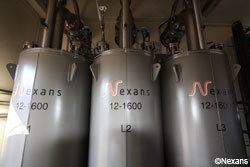News Release from Nexans Deutschland GmbH
Wind Industry Profile of
UK: Superconducting fault current limiters for Birmingham

Western Power Distribution has integrated two superconducting fault current limiters (sFCL) from Nexans into Birmingham’s power grid. Nexans designed and manufactured both sFCLs (rated at 12 kV), now its third sFCL project in the UK.
Nexans delivered the first sFCL to the Chester Street substation in late 2015, and the second to Bourneville substation. Both sFCLs are now permanently integrated into the grid. The technology opens up new ways of designing distribution grids, such as with coupling busbars to maintain a reliable power supply during maintenance.
Nexans’ sFCLs are part of the FlexDGrid project which aims to increase the capacity of existing networks to facilitate the distribution of renewable energy in Birmingham. The £17M project will transform the grid in the city, reducing power cuts and carbon emissions.
Superconducting fault current limiters
sFCLs are already in use in locations around Europe. Since 2005, Nexans has successfully installed the technology at five other sites across the UK and Germany, including as part of the Ampacity project in Essen, Germany. The sFCL in Essen has been in successful operation since March 2014.
Nexans developed superconducting fault current limiters as part of its commitment to provide the most innovative and reliable solutions to future proof grids. sFCLs provide effective protection from fault currents which constitute a growing issue in power grids. They can also help reduce the need for new substations.
The technology is based on the physical properties of the ceramic superconducting material employed. In its operating state, the material acts as a near perfect electrical conductor without ohmic resistance, and therefore doesn’t affect grid operations. A fault current, however, will transform the superconductor into a resistive material, increasing the resistance and reducing the fault current in a few milliseconds.
Frank Schmidt, Head of the Superconductivity Business Unit at Nexans said, “We’re excited to have completed delivery of superconducting fault current limiters to Western Power Distribution for permanent integration into the grid. This further demonstrates Nexans’ ability as market leader in superconducting systems for power grids. This contract represents Nexans’ commitment to continuing the deployment of state of the art equipment to address the world’s ever changing energy needs.”
Jonathan Berry, Innovation and Low Carbon Networks Engineer at WPD, said: “Nexans’ proactive approach meant that following device testing we were able to successfully install and commission the sFCLs at Chester Street and Bournville substations. The devices are now on load and we’re waiting to see their performance under a real network fault situation.”
- Source:
- Nexans
- Link:
- www.nexans.com/...

